Twin sealed woofers, other downfire can give good results. Easy to diy
https://www.audioholics.com/subwoofer-reviews/perlisten-r212s-sub/conclusion

https://www.audioholics.com/subwoofer-reviews/perlisten-r212s-sub/conclusion
Vertically positioned drivers with heavy cones (subwoofers typically) should be rotated 180deg periodically, to prevent suspension+spider sagging. Sagging can make voice coil to rub against magnet, and produce heavy distortion. At least theoretically, I've read this somewhere, but I've never done that myself 😉
I have two 4-way speakers with SEAS 26LROY subs, sealed downfire. The have been playing almost every day for 9 years now. No signs of sagging or increased distortion. Distortion measurement was taken two days ago with the speaker in same location as in the picture, some of distortion peaks come from furniture resonating. Me happy.
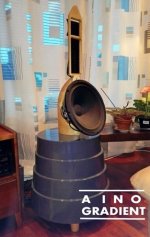
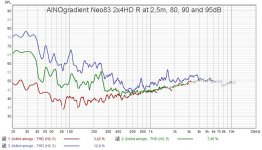
I have two 4-way speakers with SEAS 26LROY subs, sealed downfire. The have been playing almost every day for 9 years now. No signs of sagging or increased distortion. Distortion measurement was taken two days ago with the speaker in same location as in the picture, some of distortion peaks come from furniture resonating. Me happy.


Last edited:
Dancing sub:
An issue no one seems to have mentioned: With SMPD and Class D amps, the unit can be high power and light-ish weight. Without enough mass the sub can "dance" around the room. Its up and down thrusting can overcome the feet friction to the floor. I have seen this happen. The first prototype of a super low cost sub needed a modest sized engineer to sit on it for it to work. As there was no budget for lead weights, bricks or a bigger magnet, it was cancelled in 10 minutes. Someone didn't think it through at the initial stage...
An issue no one seems to have mentioned: With SMPD and Class D amps, the unit can be high power and light-ish weight. Without enough mass the sub can "dance" around the room. Its up and down thrusting can overcome the feet friction to the floor. I have seen this happen. The first prototype of a super low cost sub needed a modest sized engineer to sit on it for it to work. As there was no budget for lead weights, bricks or a bigger magnet, it was cancelled in 10 minutes. Someone didn't think it through at the initial stage...
She is suddenly a big fan of D&B, Electronica and Christopher Nolan movies!Perhaps wifey could sit on it, providing her with rear massage.
Right, I'm a 'broken record' re the cab has to either be heavy enough to stay planted or add removable mass on top/whatever and this means at least as much as the speaker weighs as a starting point.
If you feel like a broken record, you did so in another thread. That's why I volunteered the information.Right, I'm a 'broken record' re the cab has to either be heavy enough to stay planted or add removable mass on top/whatever and this means at least as much as the speaker weighs as a starting point.
The issue for me and downward firing anything is the vibration. If I use anything that does mount on the bottom it is not active and it is in a slot. A passive radiator mounted to the bottom fires inward when the active fire outward. The mechanical dampening on the drivers now are pretty impressive. Double spiders and direct coupled power amps center any of the drivers I use up to 18". I haven't tried any of the 21. I use simple PE Ultimax, HO or HFs drivers.
After years of making 60-72" bass towers, large bass bins (under 48" to 36") band pass, mid riders dual 12,15 active and 15" passive (under 36" over 18") or low riders, under 18" tall. They all do the same thing I don't care how the cabinet is designed (to a point). They shake the structure they are in, unless, the cabinets are physically decoupled from the room.
Open bottom cabinets couple with the floor and throw everything out of time. The floor (now a driver) will arrive at the seated position before the sub/bass waves in the room from the different subs. You can smooth the waves in the room. The only way to fix the room from vibrating out of time is to decouple the sub/base cabinets. Spring, pods or air ride are the only way to really do the job. It may take combinations of one or more ideas to really controlled dampening. Air bags, springs and dampeners for a TT set up. Some people don't like to use rumble filters.
I've use IB or Passive radiators in subs. I've never used a fixed port. I also design around a very light spring, light coned, passive radiator. It's light enough to use Mortite for weight so you can tune the driver to the room and the amp. You just pinch putty the size of a sweat pea at a time. I use adjustable helmholtz traps for the peeks. 100 to 280hz I use bass towers. The mains are LS planars and ribbons. Very simple actually.
The main room I use a servo system. GR OB subs are a easier on my ears in a ported room. No sealed rooms for me. I get to high of an X-max. My (ear) drums don't like hitting the bump stops. I had concussive hearing as a youngster. It will keep you on edge. LOL ALL of the cabinets are decoupled in every system, even the old workshops. The bass bins set on innertubes at 5psi.
To make a short story long, read the above. The short version is keep bass drivers away from borders unless you want everyone else to feel the BASS through their bottoms and feet.
Regards
After years of making 60-72" bass towers, large bass bins (under 48" to 36") band pass, mid riders dual 12,15 active and 15" passive (under 36" over 18") or low riders, under 18" tall. They all do the same thing I don't care how the cabinet is designed (to a point). They shake the structure they are in, unless, the cabinets are physically decoupled from the room.
Open bottom cabinets couple with the floor and throw everything out of time. The floor (now a driver) will arrive at the seated position before the sub/bass waves in the room from the different subs. You can smooth the waves in the room. The only way to fix the room from vibrating out of time is to decouple the sub/base cabinets. Spring, pods or air ride are the only way to really do the job. It may take combinations of one or more ideas to really controlled dampening. Air bags, springs and dampeners for a TT set up. Some people don't like to use rumble filters.
I've use IB or Passive radiators in subs. I've never used a fixed port. I also design around a very light spring, light coned, passive radiator. It's light enough to use Mortite for weight so you can tune the driver to the room and the amp. You just pinch putty the size of a sweat pea at a time. I use adjustable helmholtz traps for the peeks. 100 to 280hz I use bass towers. The mains are LS planars and ribbons. Very simple actually.
The main room I use a servo system. GR OB subs are a easier on my ears in a ported room. No sealed rooms for me. I get to high of an X-max. My (ear) drums don't like hitting the bump stops. I had concussive hearing as a youngster. It will keep you on edge. LOL ALL of the cabinets are decoupled in every system, even the old workshops. The bass bins set on innertubes at 5psi.
To make a short story long, read the above. The short version is keep bass drivers away from borders unless you want everyone else to feel the BASS through their bottoms and feet.
Regards
Couldn't you put it on springs? Perhaps a square of mdf (with rubber underneath) on the floor, with a spring at each corner to support the sub.Dancing sub:
An issue no one seems to have mentioned: With SMPD and Class D amps, the unit can be high power and light-ish weight. Without enough mass the sub can "dance" around the room. Its up and down thrusting can overcome the feet friction to the floor. I have seen this happen. The first prototype of a super low cost sub needed a modest sized engineer to sit on it for it to work. As there was no budget for lead weights, bricks or a bigger magnet, it was cancelled in 10 minutes. Someone didn't think it through at the initial stage...
Many threads actually over many forums, DIY Meets, etc., over many decades and now on this one. 😉If you feel like a broken record, you did so in another thread. That's why I volunteered the information.
This thread reminded yet again I've never used the math to determine if my 20 Hz Fs, ~3 mm Xmax Altec 515Bs would sag and sure enough big time at ~20.71%!Other option for building down firing sub is to allow enough space on the bottom so it can be mounted magnet down, and simply flip it magnet up from time to time.
Cheers!
Modern subs have 30mm Xmax (point to point) instead of 6mm. Other important parameters are Mms and Kms (curve) Even more important is the weight of the unit (driver, box etc.) The heavier the better. No springs, they resonate!
https://audioxpress.com/article/test-bench-the-15ds100-15-pro-sound-subwoofer-from-b-c-speakers
https://data-bass.com
https://audioxpress.com/article/test-bench-the-15ds100-15-pro-sound-subwoofer-from-b-c-speakers
https://data-bass.com
Well because this is DIY here is a tip. Use memory foam ear plugs and install them inside the springs on the spring pods. you can also wrap the spring with, 1. 2. 3, wraps of teflon and install them in the pockets. If you really want to treat the 5-10.00 spring pods to a great upgrade spray the springs with "Flex Seal" and add the ear plugs. There is NO ring with the springs mentioned. I ordered 12 sets of 4 just 3 days ago. They are better than eatin' bugs.The heavier the better. No springs, they resonate!
I spent a lot of years as a heavy duty mechanic, dealing with destructive harmonics on machinery and surrounding structures. You get a pretty good idea how to correct most issues. You can never tighten something so much it won't move. If its vibrating it will move. It will move the way it was designed to move hopefully. When isolators or balancers fail it's expensive. As concrete and the soil below it dries it shrinks more and more. Slabs and the ground below dry if the slab is covered. That goes on for years. Soon there is a gap of a few inches between the center of the slab and the actual soil below it.
The reason points on cabinets don't work without a 360 approach to vibration. Points and springs work very good. They Points alone transfer a vibration that is out of time with the actual drivers. Concrete is like a drum. It is actually the worst of all the flooring if it's not set on friction peers at least. I can't remember what they call it, but they bolt the slab to the friction peers. That helps.
You can account for the movement and dampen it's effects. I use very heavy cabinets and dense materials, to a point. One set of main I use (ed) are 390lb each before they are tip up on to a 60lb base. The base are on pods set for up to 550lbs. You can add sand to the main speakers if you blank the bass sections and add the liner and filler port. The pods are good to 4 or 5hz. with no sand. This cabinet has a great bass section but, it still vibrates the mids and highs. I quit using it.
280-300hz and below drivers are in separate cabinets. No more drivers coming loose either.
I don't have any cabinet dancing across the floor. But the lightest sub cabinet I have with drivers and floor plates is over 150lbs
Mass loading the cabinet and then isolation from the floor is good. I've seen people clamp cabinets and take decay rates.
It works. But the way it looks. With all thread and plates, BUT you can load the heck out of a cabinet. I'm sure the wife will beat you in your sleep too. Just plunk a big ol bag of manure on top that will work and have the same wife effect. 🙂
I haven't put or used sub/bass drivers in the same cabinets with mid and highs for 25 years. I quit trying to fix the unfixable. The harmonics issue with some systems will back the screws out of sheet rock.
So again I try to decouple everything.
I like GRs and Rythmik subs. I own 3 set of doubles. Wonderful. They are mounted on Queen Ann stubbys. I did the same with bass columns. They are SAT by design. (Stack and Test) The 8" bass columns stack up to 3 modules high. Behringer 12K per column. They are direct coupled with short fat cables. They actually have good cone control with a DCX2496 controller. Rythmik plates for the OB subs. Good flexible bass system. Sure works great with small planars and ribbons.
I'm working on TWO rooms at the same time. I'm dealing with it hip deep so to speak.
Side note: I'm using modded RMx Elixirs with the bass section below or any monitor for that matter. One of those lifetime projects it seems. I'm hardheaded. No downward firing drivers being used though. There are 1.5" BB attached to all the cabinets now. I tried sand pits that worked. What's the point of leg if you can't see them? Stupid physics. 😎
I like seeing legs, even short stubby ones. Turn Tables next.
Attachments
Last edited:
Add a butt plate to the bottom (slot load) the bass driver. It cost 20.00 usd to try. Throw a pillow under the plate after you attach it. Do it to ONE speaker. Use anything, just slightly larger than the legs OD, but enclose the slot and decouple ONE speaker. If you like sound effects for HT, leave it open. 🙂My downfires weigh 42kg. the 10" SEAS can't make them dance. Felt pads on legs.
View attachment 1092693 View attachment 1092695
Neither do these, weight 25kg with SB29NRX
View attachment 1092699
- Home
- Loudspeakers
- Subwoofers
- Cons of down firing Subwoofer?
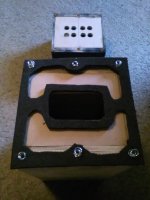
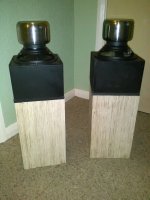
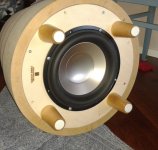
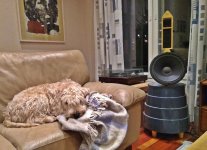
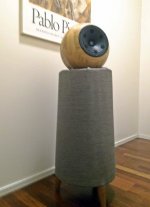
![20200620_004052[1].jpg](/community/data/attachments/1000/1000652-9540fb7b225d4eb8f1b0d9a132f41014.jpg?hash=lUD7eyJdTr)